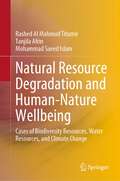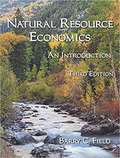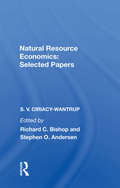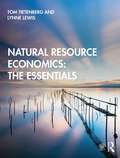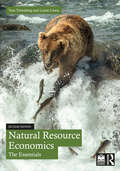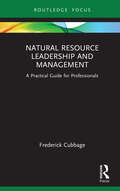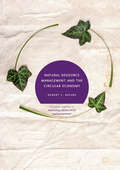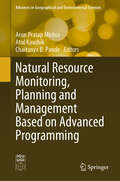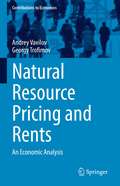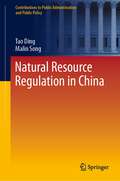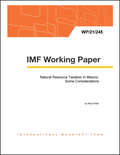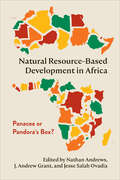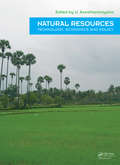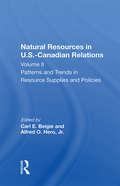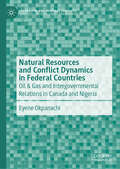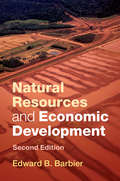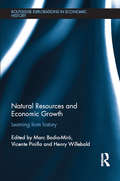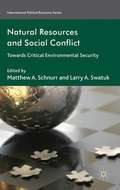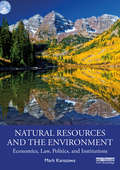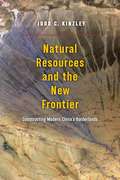- Table View
- List View
Natural Resource Degradation and Human-Nature Wellbeing: Cases of Biodiversity Resources, Water Resources, and Climate Change
by Rashed Al Titumir Tanjila Afrin Mohammad Saeed IslamThe book addresses the gaps in the body of knowledge from two grounds. Firstly, it adds value through explaining the dynamics of natural resource governance by focusing on the particular arenas of biodiversity resources, water resources and climate change in developing country context. Secondly, it critically scrutinizes the market-centric perspectives on one hand and combines political economy questions that are generally overlooked in discussions of current resource governance framework, on the other. It develops a new framework to examine the reasons behind the degradations of natural resources to offer sustainable solutions to the problems. It shows that the natural resources have been exploited beyond sustainable limits due to the structural rigidities, embedded in, and reproduced by, fragile institutions and unequal power-sharing arrangements under the market-centric economic system. The book formulates a new understanding of sustainability in case of usage and management of natural resources by incorporating the idea of human sociality. It highlights the importance of the well-being of nature, and human beings must go side by side; one without the other is not a sustainable option. The book contains key learnings for scholars and researchers working in the field of development studies who wish to gain a deeper understanding on the sustainable natural resource governance specifically in the contexts of developing countries. For policymakers and policy advocates, the book serves as the groundwork on policies regarding biodiversity resources, water resources, and climate change, specific to the context of developing countries, providing more relevant contents in terms of laying out justification for policy objectives.
Natural Resource Economics: An Introduction
by Barry C. FieldDecisions about the conservation and use of natural resources are made every day by individuals, communities, and nations. The latest edition of Field's acclaimed text highlights the incentives and trade-offs embedded in such decisions, providing a lucid introduction to natural resource issues using the analytical framework of economics.<P><P> Employing a logical structure and easy-to-understand descriptions, Field covers fundamental economic principles and their general application to natural resource use. These principles are further developed in chapters devoted to specific resources. Moreover, this up-to-date volume addresses the challenge of achieving socially beneficial utilization rates in the twenty-first century amid continuing population growth, urbanization, and global climate change.
Natural Resource Economics: Selected Papers
by S. V. Ciriacy-WantrupThis volume was assembled by two of Dr. Wantrup's students as a complement to his textbook, Resource Conservation: Economics and Policies. Wantrup's ideas on conservation economics continued to evolve in ways that were never fully reflected in that text, and although for the student of natural resource economics it is still essential reading, to st
Natural Resource Economics: The Essentials
by Tom Tietenberg Lynne LewisNatural Resource Economics: The Essentials offers a policy-oriented approach to the increasingly influential field of natural resource economics that is based upon a solid foundation of economic theory and empirical research. Students will not only leave the course with a firm understanding of natural resource economics, but they will also be exposed to a number of case studies showing how underlying economic principles provide the basis for specific natural resource policies. Including current data and research studies, this key text also highlights what insights can be derived from the actual experience. Key features include: Extensive coverage of the major issues including energy, recyclable resources, water policy, land conservation and management, forests, fisheries, other ecosystems, and sustainable development; Introductions to the theory and method of natural resource economics including externalities, experimental and behavioral economics, benefit-cost analysis, and methods for valuing the services provided by the environment; Boxed ‘Examples’ and ‘Debates’ throughout the text which highlight global examples and major points for deeper discussions. The text is fully supported with end-of-chapter summaries, discussion questions, and self-test exercises in the book, as well as with multiple-choice questions, simulations, references, slides, and an instructor’s manual on the Companion Website. This text is adapted from the best-selling Environmental and Natural Resource Economics, 11th edition, by the same authors.
Natural Resource Economics: The Essentials
by Tom Tietenberg Lynne LewisNatural Resource Economics: The Essentials offers a policy-oriented approach to the increasingly influential field of natural resource economics that is based upon a solid foundation of economic theory and empirical research. Students will not only leave the course with a firm understanding of natural resource economics, but they will also be exposed to a number of case studies showing how underlying economic principles provided the foundation for specific natural resource policies. This key text highlights what insights can be derived from the actual experience.Key features include: Extensive coverage of the major issues, including energy, recyclable resources, water policy, land conservation and management, forests, fisheries, other ecosystems, and sustainable development Introductions to the theory and method of natural resource economics, including externalities, experimental and behavioral economics, benefit-cost analysis, and methods for valuing the services provided by the environment Boxed "Examples" and "Debates" throughout the text, which highlight global cases and major talking points. This second edition provides updated data, new studies, and more international examples. There is a considerable amount of new material, with a deeper focus on climate change. The text is fully supported with end-of-chapter summaries, discussion questions, and self-test exercises in the book, as well as a suite of supplementary digital resources, including multiple-choice questions, simulations, references, slides, and an instructor’s manual. It is adapted from the 12th edition of the best-selling Environmental and Natural Resource Economics textbook by the same authors.
Natural Resource Leadership and Management: A Practical Guide for Professionals (Routledge Focus on Environment and Sustainability)
by Frederick CubbageThis book examines leadership and management in natural resources, drawing on literature, principles, and the author’s own experiences as a leader and activist. Developing a general framework summarizing the leadership and management cycle in natural resources for practitioners, the book provides a synthesis of leadership theory and practice stemming from the personal and spiritual values of work, and the key principle of aligning organizational resources and actions with stated intentions. It discusses the somewhat unique context of natural resources, comprised of private and public goods and services and complex societal values. Key strategies that enable natural resource professionals to be leaders at all stages and positions in their career, including vision and sustainability, proficient human resources management, fairness and merit, and transparency and openness are analyzed. Case studies of famous natural resource leaders and activists, including Ding Darling, David Attenborough, Wangari Maathai, Marina de Silva, Greta Thunberg, Bob Brown, and Christina Koch, are included. The book examines their values, training, and principles and how they influenced national or global natural resource management. Drawing on the author’s own experiences as a leader and activist, including his role as Department Head at North Carolina State University, as an elected officer in the Society of American Foresters, and as an activist opposing the sale of the Hofmann Forest, the book provides practical examples and guidelines that professionals can consider and use in their careers. This book will be of great interest to natural resource managers and professionals as well as students studying environmental management and natural resource governance and to practitioners who are looking to develop broader leadership and management skills.
Natural Resource Management and the Circular Economy
by Robert C. BrearsThis book provides insight into how governments are using a variety of innovative fiscal and non-fiscal instruments to develop circular economies with significant economic and environmental benefits. It emphasises the urgent need for these circular economies and to move away from our current, linear model that has led to environmental degradation, volatility of resource prices and supply risks from uneven distribution of natural resources.Natural Resource Management and the Circular Economy illustrates how governments have promoted the development of an economy that can provide substantial net material savings; mitigate price volatility and supply risks; and improve ecosystem health and long-term resilience of the economy. Through a series of case studies, it details the various innovative policy instruments which can be utilised, including regulations; market-based instruments; incentives; research and innovation support; information exchanges; and support for voluntary approaches. The book also proposes a series of best practices for different countries, both developed and developing, who are implementing their circular economy.
Natural Resource Monitoring, Planning and Management Based on Advanced Programming (Advances in Geographical and Environmental Sciences)
by Chaitanya B. Pande Arun Pratap Mishra Atul KaushikThis book focuses on cloud-based platforms, advanced programming, machine learning models and programming approaches to assess water and other natural resources, flood impact, land use land cover (LULC), global forest change, global forest canopy height and pantropical nation-level carbon stock, among other areas. Sustainable management of natural resources is urgently needed, given the immense anthropogenic pressure on the environment and the accelerated change in climatic conditions of the earth; therefore, the ability to monitor natural resources precisely and accurately is increasingly important. To meet this demand, new and advanced remote sensing tools and techniques are continually being developed to monitor and manage natural resources effectively. Remote sensing platforms use various sensors to record, measure and monitor even minor variations in the earth's surface features as well as atmospheric constituents. This book shows how environmental and ecological knowledge and satellite-based information can be effectively combined to address a wide array of current natural resource management needs. Each chapter covers the different aspects of a remote sensing approach to effectively monitor natural resources and provide a platform for decision making and policy. The book is a valuable resource for researchers, scientists, NGOs and academicians working on climate change, environmental sciences, agriculture engineering, remote sensing and GIS, natural resources management, hydrology, soil sciences, agricultural microbiology, plant pathology and agronomy.
Natural Resource Pricing and Rents: An Economic Analysis (Contributions to Economics)
by Andrey Vavilov Georgy TrofimovThis book examines the economics of natural resource markets and pricing, as well as the field of natural resource economics in general. It presents the key contributions to this field of research, including the pioneering works and contemporary studies. The book highlights the basic principles and ideas underlying theoretical models of resource pricing. The models considered in the book underline the fundamental determinants of resource prices and the economic nature of rents for non-renewable and renewable resources. Besides the classical theory of exhaustible resource economics, the book includes several issues that are of high importance for global economic growth, such as the transition to alternative energy and the economics of climate change. The authors also consider the issues of commodity pricing and a resource cartel’s activity that are relevant to the world oil market.The book provides analytical solutions illustrated with numerical examples. It allows an intuitive understanding of the subject and the model inferences through graphical illustrations and an informal introduction. It, therefore, is a must-read for everybody interested in a better understanding of resource prices, resource markets, and resource economics.
Natural Resource Regulation in China (Contributions to Public Administration and Public Policy)
by Tao Ding Malin SongThis book makes an in-depth study of China’s natural resource regulatory system including theoretical basis, development process, asset accounting, ownership reform, system structure, legal safeguard and policy implications. China is a big country with vast natural resource. Improving the supervision system of natural resources and enhancing the supervision capacity of natural resources have become the top priority of China's economic and social development. This book focuses on how to establish an optimized, coordinated and efficient natural resource regulatory system in China and aims to improve China’s natural resource regulatory system. By combing through the process of historical change, analyzing resource accounting and pricing methods and studying the realization and reform of property rights, this book discusses China’s current problems in the process of natural resource regulation and then proposes solutions and implementation paths as a reference for the construction of the Chinese natural resource regulatory system. People who are interested in natural resource regulation could find something useful in this book.
Natural Resource Taxation in Mexico: Some Considerations (Imf Working Papers)
by Alpa ShahA report from the International Monetary Fund.
Natural Resource Use and Global Change
by Karl BruckmeierBuilding on recent developments in social ecology, this book advances a new critical theory of society and nature, exploring social metabolism and global resource flows in contemporary society. Barriers to global sustainability are identified and conditions for transforming industrial economies towards new sustainable resource use are described.
Natural Resource and PPP Infrastructure Projects and Project Finance: Business Theories and Taxonomies (Economics, Law, and Institutions in Asia Pacific)
by Takao HiguchiThis is one of the first books that comprehensively explains fundamental theories of natural resource and infrastructure public private partnership (NRI–PPP) projects and project finance.NRI–PPP projects and project finance have been adopted in natural resource development, including oilfield development, mine development, and liquefied natural gas production; manufacturing, such as petrochemistry, which uses crude oil; and infrastructure-related projects such as railways, roads, airports, ports, water supply, waste treatment, communications, and electricity.An important concern during negotiations among the various stakeholders is the lack of congruence between theories underlying NRI–PPP projects and project finance and the particular, real-life business considerations of the subject project and lack of understanding of the key theories. Studies that help us understand NRI–PPP projects and project finance have been developed based on economic theories such as contract theory and the economics of law by several distinguished professors. Until now, however, in financial institutions staff in departments that specialize in project finance have developed an understanding of the theories underlying NRI–PPP projects and project finance primarily through on-the-job training during which business points of view were passed on. Principles and theories regarding NRI–PPP projects and project finance have not been taught through textbooks in these firms. In fact, there are only a few books that explain the fundamental theories for actual project structures or actual project finance. This book attempts to fill that gap by making clear the fundamental theories that exist behind the actual projects and project finance in relation to natural resources and infrastructure. Readers of this book will include not only professionals in various private sectors and banks but also those involved in PPP projects in the public sector.
Natural Resource-Based Development in Africa: Panacea or Pandora’s Box?
by Nathan Andrews J. Andrew Grant Jesse Salah OvadiaThere is no question that Africa is endowed with abundant natural resources of different magnitudes. However, more than a decade of high commodity prices and new hydrocarbon discoveries across the continent has led countless international organizations, donor agencies, and non-governmental organizations to devote considerable attention to the potential of natural resource–based development. Natural Resource–Based Development in Africa places a particular emphasis on the actors that help us understand the extent to which resources could be transformed into broader developmental outcomes. Based on a wide variety of primary sources and fieldwork, including in-person interviews and participant observations, this collection contributes to both scholarly and policy discussions around the governance and economic development roles of local entrepreneurs, transnational firms, civil society groups, local communities, and government agencies in Africa’s natural resource sectors. Natural Resource–Based Development in Africa explores the impact that these actors have on regional trends such as resource nationalism and local procurement policies as well as grassroots-related issues such as poverty, livelihoods, gender equity, development, and human security.
Natural Resources - Technology, Economics & Policy
by U. AswathanarayanaNatural resources management has two principal dimensions : Science-illuminated (earth, space, hydrological, pedological, information, etc. sciences) management of local resources (waters, soils, bioresources, minerals, rocks, sediments, etc.) in an ecologically-sustainable manner, and Value-addition through processing of natural products, through
Natural Resources In U.s.-canadian Relations, Volume 2: Patterns And Trends In Resource Supplies And Policies
by Carl E. BeigieThe combined efforts of the World Peace Foundation, the G. D. Howe Research Institute, and the Centre Quebecois de Relations Internationales have culminated in a comprehensive three-volume study of critical U.S.-Canadian resource issues. Motivated initially by the tensions of the mid-1970s and by immediate U.S. concerns about the actions of its maj
Natural Resources Utilization in China: Evaluation, Coordination, and Effects (Contributions to Public Administration and Public Policy)
by Tao Ding Malin Song Jiandong ChenThis book focuses on the evaluation, coordination, and effects of China’s natural resource utilization. By adopting both quantitative and qualitative analyses, this book objectively evaluates the spatial distribution characteristics and coupling relationship of China’s natural resource utilization based on the status quo and prominent problems during resource utilization. Moreover, the environmental, economic, and price fluctuation effects of China’s natural resource utilization are discussed. Finally, current policy systems for efficient utilization of natural resources in China and abroad are provided, which suggest a way for China to achieve efficient utilization of natural resources through an appropriate policy mechanism. This book aims to seek the balance the utilization of natural resources and sustainable development in China. It puts forward a new paradigm of natural resource utilization by incorporating the efficiency evaluation, coordination measures, and effect mechanisms of different kinds of natural resources. The evaluation system and related research methods for the efficient utilization of natural resources are very mature, laying a foundation for the development of this book’s content. As the conservation of natural resources is widely accepted, this book helps readers understand how to achieve efficient natural resource utilization in China. Meanwhile, the study of resource utilization in China can provide insights for other countries.
Natural Resources and Conflict Dynamics in Federal Countries: Oil & Gas and Intergovernmental Relations in Canada and Nigeria (Federalism and Internal Conflicts)
by Eyene OkpanachiThis book examines the dynamics of oil and gas conflicts within the context of federalism in Canada, an older federation with broadly a decentralized institutional design governing oil and gas, and Nigeria, a newer federation with a largely centralized design. It traces resource ownership, control or regulation, and revenue sharing conflict processes over time, and provides a focused comparison of conflict over the role of oil in intergovernmental fiscal transfers in both countries. In so doing, the book provides a much-needed corrective to conventional, static notions of oil conflict as either violent or nonviolent outcomes by carefully analyzing the evolution and ebbs and flows of conflicts hidden within conflict patterns that appear to be self-reinforcing and entrenched. The book demonstrates that (de)centralization dynamics, especially the continuities and shifts in federal institutional (structural and ideational) rules about oil itself,are central to the concept of conflict dynamics. It highlights the endogenous processes of federal institutional development, and lends credence to the historical institutionalists’ emphasis on the entanglement of institutions in their own transformation. Yet, the book also reveals that conflict dynamics did not emerge solely from the initial "compromise" between federal and provincial/state actors regarding the allocation of competence over oil. The renegotiation and reinterpretation of these rules over time, which entails a redistribution of power/resources in response to historical temporalities and shocks, political agency, and changing socioeconomic realities, also generated unique patterns of conflict and conflict resolution within the federal institutional arenas.
Natural Resources and Divergence: A Comparison of Andean and Nordic Trajectories (Palgrave Studies in Economic History)
by Cristián Ducoing José Peres-CajíasIs the 'natural resource curse' destiny? Are different ways to link natural resources and economic development? Using two particular regions as case studies, this edited collection examines the divergent development paths of natural resource rich countries over the past two centuries. Bolivia, Chile and Peru are neighbour states with a common history and are globally known by their mining endowments. Norway and Sweden have also a strong common history, and different natural resource endowments (forestry, mining and fishing) are essential to understand their current economic success. By comparing natural resource management in the long run in these two divergent regions, this book can help rethink how developing countries can better take advantage of their natural resource endowments. Specifically, the book examines the interaction between natural resources and different key determinants of long-term development: trade, fiscal policy, sustainability, human capital accumulation and business strategies.
Natural Resources and Economic Development
by Edward B. BarbierWhy is natural resource exploitation not yielding greater benefits for the poor economies? In this second edition of his landmark book, Barbier explores this paradox in three parts. Part I gives a historical review of resource use and development, examining current theories that explain the under-performance of today's resource-abundant economies, and proposing a hypothesis of frontier expansion as an alternative explanation. Part II develops models to analyse the key economic factors underlying land expansion and water use in developing countries. Part III explores further the structural pattern of resource dependency, rural poverty and resource degradation within developing countries, and through illustrative country case studies, proposes policy and institutional reforms necessary for successful resource-based development. First published in 2005, each chapter in this new edition has been thoroughly revised and updated, with new material, tables, figures and supporting empirical evidence. It will appeal to graduate students and scholars researching environmental and developmental economics.
Natural Resources and Economic Growth: Learning from History (Routledge Explorations in Economic History)
by Vicente Pinilla Henry Willebald Marc Badia-MiróThe relationship between natural capital and economic growth is an open debate in the field of economic development. Is an abundance of natural resources a blessing or a curse for economic performance? The field of Economic History offers an excellent vantage to explore the relevance of institutions, technical progress and supply-demand drivers. Natural Resources and Economic Growth contains theoretical and empirical articles by leading scholars who have studied this subject in different historical periods from the 19th century to the present day and in different parts of the world. Part I presents the theoretical issues and discusses the meaning of the "curse" and the relevance of the historical perspective. Part II captures the diversity of experiences, presenting thirteen independent case studies based on historical results from North and South America, Africa, Asia, Oceania and Europe. This book emphasizes that an abundance of natural resources is not a fixed situation. It is a process that reacts to changes in the structure of commodity prices and factor endowments, and progress requires capital, labour, technical change and appropriate institutional arrangements. This abundance is not a given, but is part of the evolution of the economic system. History shows that institutional quality is the key factor to deal with abundant natural resources and, especially, with the rents derived from their use and exploitation. This wide ranging volume will be of great relevance to all those with an interest in economic history, development, economic growth, natural resources, world history and institutional economics.
Natural Resources and Local Livelihoods in the Great Lakes Region of Africa
by An Ansoms Stefaan MarysseFragile but progressive post-conflict reconstruction has allowed for a new growth-oriented logic in the Great Lakes Region of Africa. However, the opportunities provided by economic development are not being equally distributed. A struggle exists between large-scale and local small-scale actors that is particularly prevalent in the rural environment, where the increasingly prevalent scramble for natural resources impacts heavily upon local livelihoods. This is occurring both in the agricultural sector and in the mineral sector. This book analyses the opportunities and constraints for local actors' participation in economic growth. The book first looks into the contemporary challenges with regard to land relations and local livelihoods in the Democratic Republic of the Congo (DRC), Burundi and Rwanda. It then goes on to consider the ambiguities that characterise the relationship between mining and development in the DRC. This book is essential reading for students, researchers and policy makers workingon rural development in Africa and those interested in understanding post-conflict reconstruction and the way in which local level dynamics relate to the broader political economy. "
Natural Resources and Social Conflict
by Matthew A. SchnurrThis volume brings together international scholars reflecting on the theory and practice of international security, human security, natural resources and environmental change. It contributes by 'centring the margins' and privileging alternative conceptions and understandings of environmental (in)security.
Natural Resources and the Environment: Economics, Law, Politics, and Institutions
by Mark KanazawaNatural Resources and the Environment: Economics, Law, Politics, and Institutions provides a new approach to the study of environmental and natural resource economics. It augments current contributions from the fields of public choice, law, and economics, and the burgeoning field of what used to be called the "New Institutional Economics," to describe, explain, and interpret how these new developments have been applied to better understand the economics of natural resources and the environment. This textbook takes a multi-disciplinary approach, which is essential for understanding complex environmental problems, and examines the issue from not only an economic perspective, but also taking into account law, politics, and institutions. In doing so, it provides students with a realistic understanding of how environmental policy is created and presents a comprehensive examination of real-world environmental policy. The book provides a comprehensive coverage of key issues, including renewable energy, climate change, agriculture, water resources, land conservation, and fisheries, with each chapter accompanied by learning resources, such as recommended further reading, discussion questions, and exercises. This textbook is essential reading for students and scholars seeking to build an interdisciplinary understanding of natural resources and the environment.
Natural Resources and the New Frontier: Constructing Modern China's Borderlands
by Judd C. KinzleyChina’s westernmost province of Xinjiang has experienced escalating cycles of violence, interethnic strife, and state repression since the 1990s. In their search for the roots of these growing tensions, scholars have tended to focus on ethnic clashes and political disputes. In Natural Resources and the New Frontier, historian Judd C. Kinzley takes a different approach—one that works from the ground up to explore the infrastructural and material foundation of state power in the region. As Kinzley argues, Xinjiang’s role in producing various natural resources for regional powers has been an important but largely overlooked factor in fueling unrest. He carefully traces the buildup to this unstable situation over the course of the twentieth century by focusing on the shifting priorities of Chinese, Soviet, and provincial officials regarding the production of various resources, including gold, furs, and oil among others. Through his archival work, Kinzley offers a new way of viewing Xinjiang that will shape the conversation about this important region and offer a model for understanding the development of other frontier zones in China as well as across the global south.
